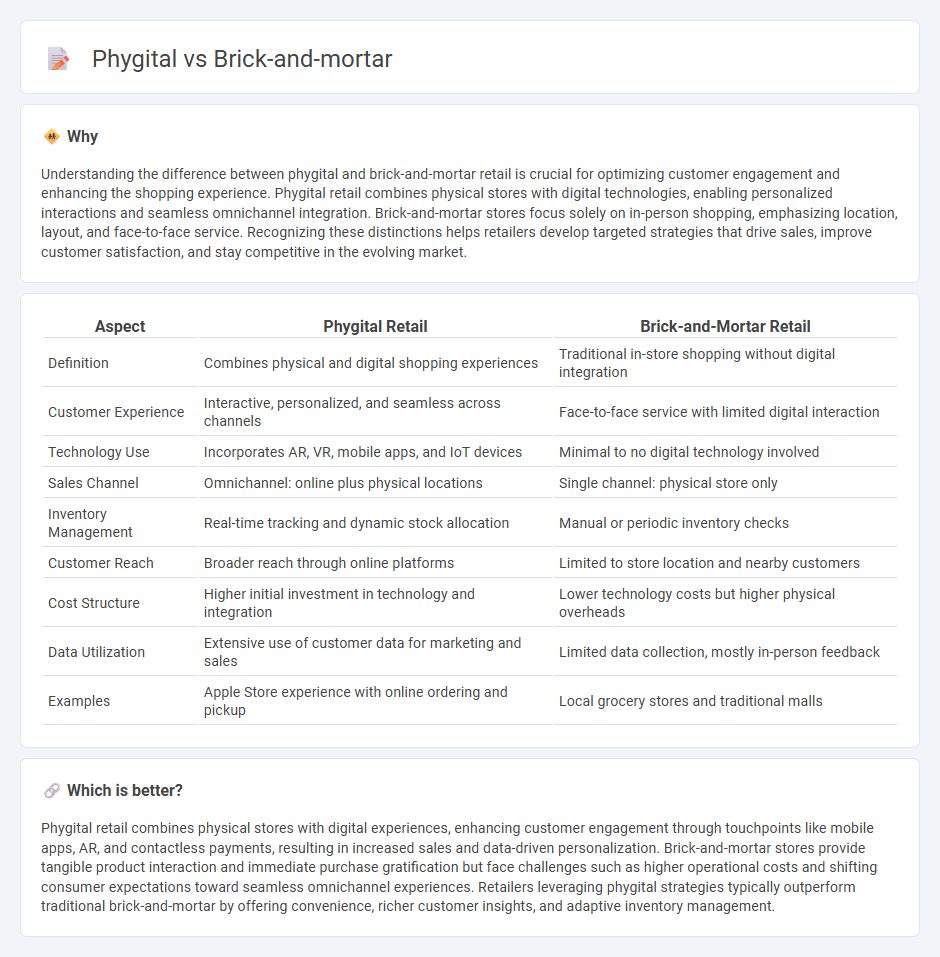
Phygital retail seamlessly integrates physical stores with digital technology to enhance customer experience, offering interactive displays, AR fitting rooms, and real-time inventory updates. Brick-and-mortar retail relies solely on traditional in-person shopping without digital enhancements, focusing on tactile product interaction and immediate customer service. Explore the evolving landscape of retail to understand how phygital innovations are transforming consumer engagement.
Why it is important
Understanding the difference between phygital and brick-and-mortar retail is crucial for optimizing customer engagement and enhancing the shopping experience. Phygital retail combines physical stores with digital technologies, enabling personalized interactions and seamless omnichannel integration. Brick-and-mortar stores focus solely on in-person shopping, emphasizing location, layout, and face-to-face service. Recognizing these distinctions helps retailers develop targeted strategies that drive sales, improve customer satisfaction, and stay competitive in the evolving market.
Comparison Table
| Aspect | Phygital Retail | Brick-and-Mortar Retail |
|---|---|---|
| Definition | Combines physical and digital shopping experiences | Traditional in-store shopping without digital integration |
| Customer Experience | Interactive, personalized, and seamless across channels | Face-to-face service with limited digital interaction |
| Technology Use | Incorporates AR, VR, mobile apps, and IoT devices | Minimal to no digital technology involved |
| Sales Channel | Omnichannel: online plus physical locations | Single channel: physical store only |
| Inventory Management | Real-time tracking and dynamic stock allocation | Manual or periodic inventory checks |
| Customer Reach | Broader reach through online platforms | Limited to store location and nearby customers |
| Cost Structure | Higher initial investment in technology and integration | Lower technology costs but higher physical overheads |
| Data Utilization | Extensive use of customer data for marketing and sales | Limited data collection, mostly in-person feedback |
| Examples | Apple Store experience with online ordering and pickup | Local grocery stores and traditional malls |
Which is better?
Phygital retail combines physical stores with digital experiences, enhancing customer engagement through touchpoints like mobile apps, AR, and contactless payments, resulting in increased sales and data-driven personalization. Brick-and-mortar stores provide tangible product interaction and immediate purchase gratification but face challenges such as higher operational costs and shifting consumer expectations toward seamless omnichannel experiences. Retailers leveraging phygital strategies typically outperform traditional brick-and-mortar by offering convenience, richer customer insights, and adaptive inventory management.
Connection
Phygital retail seamlessly integrates digital technologies with brick-and-mortar stores to enhance customer experience through interactive displays, mobile payments, and personalized services. This connection allows retailers to gather real-time data from physical interactions, optimizing inventory management and targeted marketing strategies. By blending physical presence with digital convenience, retailers increase engagement and convert foot traffic into sales more effectively.
Key Terms
Physical Storefront
Brick-and-mortar stores rely on traditional physical storefronts, emphasizing in-person customer experience, tangible product interaction, and localized foot traffic. Phygital stores integrate digital technologies such as AR, QR codes, and interactive displays within the physical space to enhance engagement and streamline shopping convenience. Explore how evolving retail strategies transform physical storefronts by blending the physical and digital worlds.
Omnichannel Experience
Brick-and-mortar stores provide tangible, in-person shopping experiences while phygital combines physical and digital touchpoints to create seamless omnichannel customer journeys. Phygital strategies integrate mobile apps, augmented reality, and interactive kiosks, enhancing customer engagement and bridging online and offline channels effectively. Explore how leveraging phygital innovations can transform your omnichannel experience and drive business growth.
Digital Integration
Brick-and-mortar stores increasingly adopt phygital strategies by integrating digital technologies such as augmented reality, IoT devices, and mobile apps to enhance customer experiences and streamline operations. Digital integration in phygital environments enables real-time inventory management, personalized marketing, and seamless online-to-offline interactions, driving higher customer engagement and sales. Explore how digital integration transforms traditional retail into immersive, connected experiences that meet modern consumer expectations.
Source and External Links
Brick and mortar - Wikipedia - A brick-and-mortar business is a company with a physical presence in a building such as retail shops or warehouses, contrasting with online-only businesses that lack a physical storefront for face-to-face customer interaction.
BRICK-AND-MORTAR definition | Cambridge English Dictionary - The term brick-and-mortar describes a traditional business operating in a physical building as opposed to one that operates solely online.
Brick & Mortar Mercantile - Example of a retail business emphasizing physical, in-person customer experience with a curated collection of goods, local products, and community-oriented events, illustrating the brick-and-mortar business model.
 dowidth.com
dowidth.com